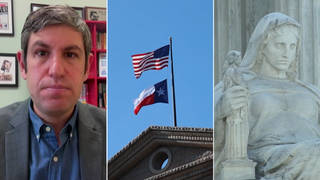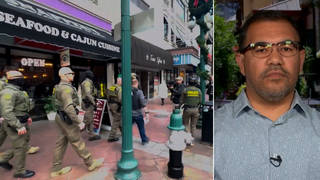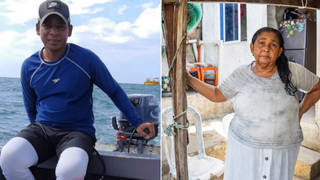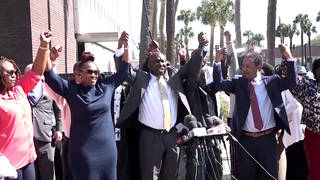
Guests
- Marisa Fuentesassociate professor of women’s and gender studies and history at Rutgers University. She is director of research for the team that produced the report, Scarlet and Black, Volume 1: Slavery and Dispossession in Rutgers History. Her first book is Dispossessed Lives: Enslaved Women, Violence, and the Archive.
A sweeping new report reveals ties to slavery and the displacement of the Native Americans at one of the country’s top colleges. The findings about 250-year-old Rutgers University were published in a new book, “Scarlet and Black, Volume 1: Slavery and Dispossession in Rutgers History.” It details the history of some of the institution’s founders, presidents and trustees as slave owners, anti-abolitionists and participants in slave trading. Rutgers is one of several colleges and universities across the country now grappling with their historical ties to slavery, including Georgetown, Yale and Harvard. For more, we speak with Marisa Fuentes, director of research for the team that produced “Scarlet and Black.” She is an associate professor of women’s and gender studies and history at Rutgers.
Transcript
JUAN GONZÁLEZ: We turn now to a sweeping new report that reveals ties to slavery and the displacement of Native Americans at one of the country’s top colleges. The findings about 250-year-old Rutgers University were published in a new book, Scarlet and Black, Volume 1: Slavery and Dispossession in Rutgers History. It reveals the history of some of the institution’s founders, presidents and trustees as slave owners, anti-abolitionists and participants in slave trading. The report, which is the culmination of eight months of research that spanned the mid-18th through mid-19th centuries, also brings out of the shadows those whose slave labor laid the foundation of the university.
Rutgers-New Brunswick Chancellor Richard Edwards said of the findings, quote, “This work shows that we are not afraid to look at ourselves and our early history. We are a large public university that is one of the most diverse in the country and we think we need to understand our history and not be ashamed of it, but to be able to face it in a forthright way.” The project was part of an initiative by Edwards and the Committee on Enslaved and Disenfranchised Populations in Rutgers History, which grew out of a meeting with a group of students concerned about improving the racial and cultural climate on the campus. Rutgers is one of several colleges and universities across the United States now grappling with their historical ties to slavery, that include Georgetown, Yale and Harvard.
For more, we’re joined by Marisa Fuentes, who’s an associate professor of women’s and gender Studies and history at Rutgers. She’s the director of research for the team that produced Scarlet and Black.
Welcome to Democracy Now!, Professor Fuentes.
MARISA FUENTES: Thanks so much, Juan.
JUAN GONZÁLEZ: Well, tell us, first of all, how this project originated and what you attempted to cover in your research that has not already become public.
MARISA FUENTES: So, part of your introduction covers that, in that we, as an institution, have been celebrating 250 years of Rutgers history from its founding in 1766. And while those celebrations have been going on over the last year under the kind of theme of revolutionary Rutgers, the chancellor, in a discussion with students, was concerned that there was part of the history that wasn’t being told or celebrated or acknowledged, so he set up, actually, a super committee and put professor Deborah Gray White in charge. The committee actually was tasked with figuring out, one, partly to do the research, the historical research, but also to think about ways to think about inclusion and diversity and retention at the university and underrepresented students and how they were feeling about the celebration, but also the kind of status of being a student of color at Rutgers.
So, as part of that committee, I joined to lead a team of graduate students to do the historical research. And what we did, really, for the first time, although I do have to say it came after Craig Wilder’s text, Ebony & Ivy, where he covers some of the history of slavery in the Ivy Leagues and because Rutgers is so—it’s so old and founded around the mid-18th century like those Ivys, he actually covered some of the work that we started with at Rutgers with the trustees. So, really, it was going back to this early history. It actually started in the 17 century.
JUAN GONZÁLEZ: Well, Professor Fuentes, before we go to that—
MARISA FUENTES: Yes, yeah.
JUAN GONZÁLEZ: —we do have a clip of an interview that—when we spoke with historian Craig Steven Wilder—
MARISA FUENTES: Yes.
JUAN GONZÁLEZ: —about the publication of his book, Ebony & Ivy: Race, Slavery, and the Troubled History of America’s Universities. And he spoke briefly in our conversation about Rutgers’ early history. I want to play that.
MARISA FUENTES: OK.
CRAIG STEVEN WILDER: One of their earliest presidents, [Jacob] Hardenbergh, the Reverend Hardenbergh at Queen’s College, manages to purchase slaves despite the fact that the college is doing quite poorly. You know, Queen’s is so financially strapped that it closes multiple times in its early history, and for long periods. But on the eve of one of its first closures, when it just has to shut down and stop operations, Reverend Hardenbergh manages to buy a second slave for his household. And what does that tell us about colleges in the 18th century? One of the things that it should remind us is that colleges survived on the margins in the 18th century. You know, they were constantly seeking sources of funding.
JUAN GONZÁLEZ: So, in your report, you pick up on some of those early findings of Wilder, but then you went on to uncover much more.
MARISA FUENTES: Yes. I mean, essentially, we wanted it to be about the founders and their relationship to the institution of slavery and the slave trade and how Rutgers benefited from that and those economic relationships, while at the same time we tasked the graduate students with really trying to search for the history of enslaved people inasmuch as you can find in this colonial archive. And they were actually able to uncover, if not the voices of some of the enslaved people that labored for the university or labored for the founders and trustees, but also really understanding that, you know, people like Sojourner Truth, who is actually very well known, has an important link to the university, her and her family. So, being able to really go into the records and search through the voices of these trustees, these white men, to try and highlight the lives of the enslaved and disenfranchised indigenous populations was a major part of this project.
JUAN GONZÁLEZ: And what was the connection of Sojourner Truth to Rutgers?
MARISA FUENTES: So, the Hardenbergh family, actually—and there were—you know, the parents and their children owned Sojourner Truth’s parents. And in that, when the parents died, Charles Hardenbergh, when his parents died, he inherited both Sojourner Truth’s parents. And Sojourner Truth was actually owned by a member of the Hardenbergh family that was living in New York. Her parents were quite elderly by the time Charles actually kind of inherited them. And oftentimes, owners did not want the responsibility to maintain elderly enslaved people. So her father was freed, and he was quite ill. And the family did not want to continue paying for his care. So they freed his wife, who was also quite elderly, to take care of him. And, unfortunately, she passed away without being able to take care of him, and he shortly also passed away. From her narrative and biographies about Sojourner Truth, her father passed away from either starvation or cold in the living conditions he was left in by the family.
JUAN GONZÁLEZ: Your report also talks about the role of some of the Rutgers trustees during the time when the state of New Jersey began to phase out slavery. Could you talk about that, as well?
MARISA FUENTES: Sure. So, New Jersey passed a Gradual Abolition Act in 1804. And what that meant was that if an enslaved person was born after 1804, then they could gain their freedom, if they were female, after 21 years of service, and, if they were male, after 25 years of service. So, gradually, you know, slavery would phase out. If you were born prior to 1804, you remained enslaved for life.
What we discovered or what the—part of the project and what the students uncovered was that these women appeared in the records, enslaved woman in their twenties, and so they were of prime childbearing age. And they had affidavits from the courts in Middlesex County, which would be New Brunswick, giving their consent to be sold to Louisiana as enslaved people. Now, these were women who, again, were in their childbearing—prime childbearing ages and were not going to be freed, because they were born prior to 1804. But their children would have qualified for freedom after those years of service. So, somehow—and this is sort of the devastation of the archive, because we don’t have their voices or have any clue about how they made the decision to, quote-unquote, “consent” to being sold to Louisiana, which was at that time, you know, really growing their cotton industry. And so, we have these affidavits where not only these women are consenting, but children and infants are said to have consent to be sold to Louisiana. So, essentially, these trustees and their families are figuring out a way to avoid the Gradual Abolition Act by coercing enslaved people to agree to be sold down South and have—basically be enslaved for life.
JUAN GONZÁLEZ: And your report also finds that many of the presidents of Rutgers, as well as some of the trustees, were not simply supporters of slavery, they were actually members of the American Colonization Society.
MARISA FUENTES: Right.
JUAN GONZÁLEZ: If you could talk about the importance of that group in U.S. history?
MARISA FUENTES: Right. I mean, so, it depends on a myriad of factors and kind of interpreting the American Colonization Society. But historians largely agree that this organization, which was national but had branches in many states, members of this organization were not necessarily for slavery, but they certainly did not want to live with freed African Americans. So, they organized a society that raised money to send freed people to colonies in West Africa, including Sierra Leone and Liberia at the time. So, on the one hand, they’re purporting to be against slavery and the institution, while, on the other hand, they actually don’t think people of African descent are equal to whites, and certainly don’t want to share a society with them. And people such as Henry Rutgers, who, obviously, Rutgers is named for, who donated a large—gave a large donation to the college to keep it afloat, he was the president of Rutgers in the 19th century. He was one of the leaders of the organization in New Jersey and New York. He encouraged students to organize around raising money for the organization. And men, also, like Frelinghuysen—these are all men who we have buildings named after, as well—really did a lot of lecturing, a lot of gathering students and other faculty and rallying them around this idea that, you know, slavery is an evil, but we need to do something about this looming freed population of African Americans that we actually don’t want to live with or give equal rights to, so organize to send them away.
JUAN GONZÁLEZ: And could you talk, as well, about what you found about Rutgers’ legacy in terms of Native Americans in New Jersey?
MARISA FUENTES: Right. So the first part of the book really covers—and I should say this: The research—much of the research was done by an undergraduate class, which is fantastic, under the direction of my colleague, Professor Camilla Townsend. And basically, this—they went back to the 17th century, because by the time Rutgers was founded in 1766, the indigenous population had largely been moved off the land and relocated in varying degrees. So, probably about 50 to 100 years prior to Rutgers sort of laying the foundation for the college, the Native population had moved to areas such as Delaware and Wisconsin through, you know, treaties that were not fair to them, some monetary compensation that wasn’t enough. And eventually these indigenous people left the area.
But the first part of the report really covers the interactions between the people that were here on the land and the Dutch and the Dutch Reform Church that was in the area prior to the English settlement. So, we’re talking really early to mid to late 17th century. And it’s a similar story of other kind of dispossession stories of indigenous populations. Settlers, white settlers, European settlers, come in. There’s some discussion of conversion of indigenous populations. There’s ideologies of Native inferiority there. And in the report, Professor Townsend documents—she found these letters from indigenous children that had been taken from their homes to be, quote-unquote, “educated” at some of these institutions, one of which became Dartmouth, and how traumatizing it was for indigenous children to be taken from their homes and prevented from speaking their language, indoctrinated into a kind of Western education. And this was an attempt to assimilate the Native population, and it was largely unsuccessful. And eventually, when they could, indigenous people stopped sending or allowing their children to be taken. By that time, they—many of the people had actually moved to Delaware and other locations.
JUAN GONZÁLEZ: Well, Professor Fuentes—
MARISA FUENTES: It’s really a story—yes?
JUAN GONZÁLEZ: Now that you’ve uncovered a lot of this information, what is the expectation that Rutgers will do about it? Obviously, some schools, like Georgetown, have attempted to compensate for their past activities by creating new programs aimed at luring more students to the university. What are your expectations or your recommendations to the Rutgers administration?
MARISA FUENTES: Right, well, the super committee that was headed by Professor White actually was tasked with coming up with recommendations. So we have the historical report, but we also were tasked with thinking about ways to disseminate the knowledge, but also to really contend with this history and make material recommendations. So, the committee came up with a list of suggestions, some of which actually came from the undergraduate population and various constituencies on campus. These include issues such as requiring a diversity course in the undergraduate curriculum, so meaning that the undergrads would be required to take a course that covers some aspect of diversity, whether it’s through a sociology department or history department or women’s and gender studies, but that it covers the experiences of underrepresented people. Many universities have this requirement; Rutgers does not yet. And it seems an important—an important implementation for the undergrads.
Other things that came up in the recommendation report were retention scholarships for at-risk students, students that typically have a low graduation rate—these are typically underrepresented students—keeping students of color in an undergraduate program and making sure that they have the resources to graduate. Some of the other recommendations also include making this history known in the kind of infrastructure of the university, so historical markers on some of these buildings. There was some—and we’re still open to having conversations about name changing. The difficulty about changing the names of some of these buildings is that once you do that, the history and the controversy is gone. And the idea that, you know, when one comes across one of these buildings named for a slave owner or the owner of Sojourner Truth’s family and that name is changed, then you can’t actually have a conversation, possibly, about that history. So, instead of, perhaps, changing names of buildings, putting really detailed historical markers on the buildings so that, you know, you’re confronted with the reality of who this person was and who the other people might be that were enslaved by them or involved in this particular story.
JUAN GONZÁLEZ: Well, Professor Fuentes—
MARISA FUENTES: And—yes?
JUAN GONZÁLEZ: We just have like about a minute left. I just wanted to ask you about something else.
MARISA FUENTES: Sure, sure.
JUAN GONZÁLEZ: The day after the recent election, you tweeted, quote, “I feel like I’m in complete mourning today,” unquote. Can you talk about the response of the election on your campus? And I understand there have been some student protests there of late?
MARISA FUENTES: Right.
JUAN GONZÁLEZ: Can you talk about the reaction on campus to the election?
MARISA FUENTES: Yes, you know, there was a large student walkout last week, Wednesday, and the students from all over campus—Rutgers, as you know, is kind of a spread-out—where there’s different campuses in a large area. The students gathered and, at first, had a rally and then marched downtown and largely shut down the city of New Brunswick and the traffic. So, they’re definitely a large group of students who are very, very concerned about the future, about what a Trump presidency means to them, to their families, to their safety. So we’ve actually had some graffiti on campus that is targeting undocumented populations and populations of color, that say, you know, “We’re going to deport you,” and really hate—hateful, hateful graffiti. So, the students are actually—and rightly so—fearful of their safety and certainly with—they’ve gotten, as we’ve all gotten, reports of the violence against people of color and the Muslim population. So, I think that there’s definitely tension. And I think that the students and faculty are calling for the university to sort of take a stand on this issue, whether it means having a sanctuary campus where undocumented students can feel safe and protected by the institution, or really making a statement against hate speech and violence.
JUAN GONZÁLEZ: Well, Professor Fuentes, I’m going to have to leave it there.
MARISA FUENTES: Sure.
JUAN GONZÁLEZ: Marisa Fuentes, associate professor of women’s and gender studies and history at Rutgers, she’s the director of research for the team that produced Scarlet and Black, Volume 1: Slavery and Dispossession in Rutgers History. Her first book is Dispossessed Lives: Enslaved Women, Violence, and the Archive. Thank you very much for being with us. When we return, we’re going to look at this whole issue of sanctuary cities and sanctuary campuses.












Media Options